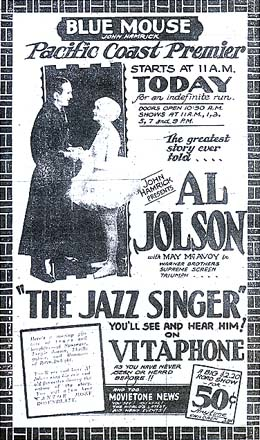Main Content
Lesson 2: The Development of Cinematic Language

The Jazz Singer
The first commercial films, a short film in this case, often called a talkie, with synchronized sound was the 1923 Phonofilm. At first, the technology was largely used to document individual personalities, like speeches given by politicians or lectures given by famous people.
The first feature length film that was distributed with sound was The Jazz Singer in 1927. If any of you have seen the film Singing In The Rain, this was a big deal. It changed the way that movies were done and it changed the way that people were cast because all of a sudden the way that a person spoke, not just how they look or emoted with their bodies, became a very crucial element in casting people.
By the 1930s the technology was essentially everywhere. Chaplin was wrong that it would be a passing fancy, and sound impacted the way in which films were made. You will see this in a bit of the short from The Jazz Singer.
Here you can see Al Jolson as the jazz singer playing in black face. This was a convention related to vaudeville. He is singing a song as a black man about his mammy down south and yet at the same time looking to his Yiddish ascetic Jewish mother in the audience.
Video 2.7: Clip from The Jazz Singer.
Clip from The Jazz Singer Video Transcript
[MUSIC - "MY MAMMY"]
AL JOLSON: (SINGING) Mammy, Mammy, the sun shines east, the sun shines west, but I know where the sun shines best. Mammy, Mammy, my heartstrings are tangled around Alabammy.
I-- I'm a-coming. Sorry I made you wait. I-- I'm coming. I hope and trust I'm not late. Mammy, Mammy, I'd walk a million miles for one of your smiles, from my Mammy. Oh, oh, oh.
Mammy, my little Mammy, the sun shines east, the sun shines west, but I know where the sun shines best. It's on my Mammy I'm talking about. Nobody else's. My little Mammy. My heartstrings are tangled around Alabammy.
Mammy, I'm coming. I hope I didn't make you wait. Mammy, I'm coming. Oh, God, I hope I'm not late.
Mammy, don't you know me? It's your little baby! I'd walk a million miles for one of your smiles, from my Mammy!
What you get in talking movies with sound is the emotional quality of the voice that is given through the presentation or dialogue. This is the kind of emotion that images themselves cannot give. You get reaction shots here to emphasize how emotional this is.
This story would catapult Jolson to international stardom, somewhat short-lived. He did a film called The Singing Fool and another. All of them had a similar conceit of a misunderstood yet eventually triumphant jazz singer. These were set in the Broadway theater district and used the power of synchronized sound to convey the emotion. The music to The Jazz Singer was by Irving Berlin. He would also become synonymous with this type of crossover of jazz into the mainstream and this is emblematic of this black-faced Jewish singer singing jazz as well.
